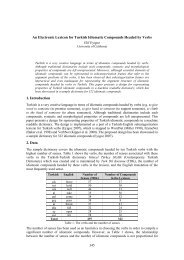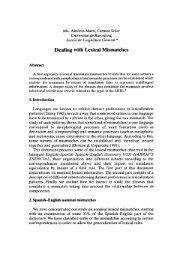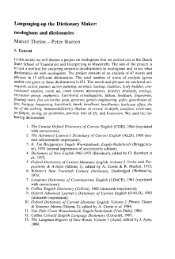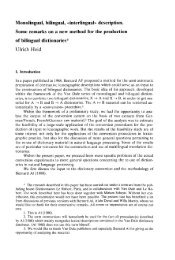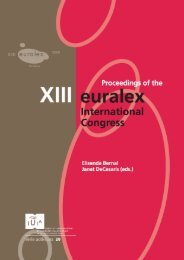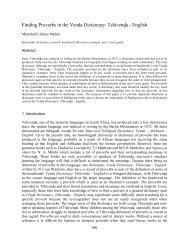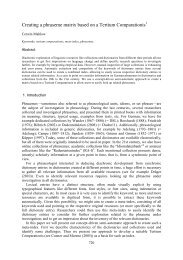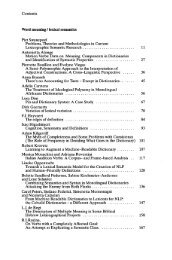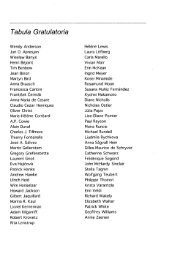Collocations in a New Bilingual Print and Electronic English - Euralex
Collocations in a New Bilingual Print and Electronic English - Euralex
Collocations in a New Bilingual Print and Electronic English - Euralex
You also want an ePaper? Increase the reach of your titles
YUMPU automatically turns print PDFs into web optimized ePapers that Google loves.
WORKSHOP ON COLLOCATIONS<br />
míss ... v/ ... PHRASES: to ~ the boat (<strong>in</strong>f: not take advantage) den Anschluss verpassen tfail to<br />
underst<strong>and</strong>) etw nicht mitbekommen; to ~ the bus den Anschluss verpassen; to ~ the mark das Ziel<br />
[o den Zweck] verfehlen; to ~ the po<strong>in</strong>t nicht verstehen, worum es geht; to not ~ a trick alle Register<br />
ziehen;<br />
<strong>Collocations</strong> with<strong>in</strong> the Framework ofMulti-Word Units<br />
<strong>Collocations</strong> are only one type of multi-word unit (MWU), which also <strong>in</strong>cludes free<br />
comb<strong>in</strong>ations <strong>and</strong> compounds. Thus, exam<strong>in</strong><strong>in</strong>g collocations with<strong>in</strong> the context ofMWUs <strong>in</strong><br />
general sheds light not only their role for the foreign language speaker but also their<br />
treatment <strong>in</strong> the bil<strong>in</strong>gual dictionary. As an ambiguous term, we would like to def<strong>in</strong>e <strong>and</strong><br />
contrast collocations with other MWUs by describ<strong>in</strong>g the def<strong>in</strong><strong>in</strong>g features of each, based on<br />
the work ofHausmann <strong>and</strong> Günthnerßilanco, as summarized below.<br />
<strong>Collocations</strong> <strong>and</strong> Free Comb<strong>in</strong>ations<br />
A free comb<strong>in</strong>ation consists oftwo lexical units, <strong>in</strong> which one modifies or restricts the other.<br />
They generally consist ofwords which Hausmann [1997] has called autosemantic elements,<br />
i.e. words which can easily be def<strong>in</strong>ed <strong>and</strong> understood without a co-text. In general, such<br />
comb<strong>in</strong>ations pose no trouble to the language learner as the translation from L1 to L2 can<br />
generally be literal, one word at a time.<br />
1. Eng.: clean air, h<strong>and</strong>s, water, face, shirt<br />
Ger.:saubereLuft/H<strong>and</strong>e, sauberes Wasser/Gesicht/Hemd<br />
<strong>Collocations</strong>, however, though also bipartite units, display an <strong>in</strong>ner relationship between the<br />
<strong>in</strong>dividual lexical units, which may be broken down <strong>in</strong>to two roles, the base <strong>and</strong> the<br />
collocator. The base ofthe collocation is the more transparent word, one that <strong>in</strong> <strong>and</strong> ofitself<br />
can be understood <strong>and</strong> as such is easy to transpose <strong>in</strong>to L2. The word that is more difficult to<br />
translate is called the collocator. Whereas the base is usually autosemantic 1 ", the collocator is<br />
usually synsemantic fHausmann 1997]. This is a word that requires a context partner <strong>in</strong> order<br />
for it to be understood. Compare example 1 above with the follow<strong>in</strong>g example:<br />
2. Eng.: a clean driv<strong>in</strong>g license, to have a clean record.<br />
Ger.: e<strong>in</strong> Führersche<strong>in</strong> ohne Strafpunkte <strong>and</strong> nicht vorbestraft se<strong>in</strong>.<br />
In example 2, a beg<strong>in</strong>n<strong>in</strong>g GFL speaker would probably translate the <strong>English</strong> collocator,<br />
clean, <strong>in</strong>to the German equivalent, sauber. A more experienced speaker would probably<br />
suspect that sauber was not correct, but would still not be able to produce the correct phrase<br />
[see Hausmann 1993]. Example 1 does not belong <strong>in</strong> the bil<strong>in</strong>gual dictionary- except for <strong>in</strong><br />
the case of mean<strong>in</strong>g differentiation <strong>and</strong> then only <strong>in</strong> an abbreviated version, whereas<br />
example 2 can't be done without.<br />
Before cont<strong>in</strong>u<strong>in</strong>g, it is important to note that some free comb<strong>in</strong>ations must be treated as<br />
collocations <strong>in</strong> the bil<strong>in</strong>gual dictionary when they pose significant difficulties <strong>in</strong> production<br />
[Cop 1990]. On the other h<strong>and</strong>, some collocations are realized <strong>in</strong> L1 <strong>and</strong> L2 <strong>in</strong> the same<br />
manner. As such they are of secondary importance <strong>in</strong> bil<strong>in</strong>gual dictionaries. This<br />
797



